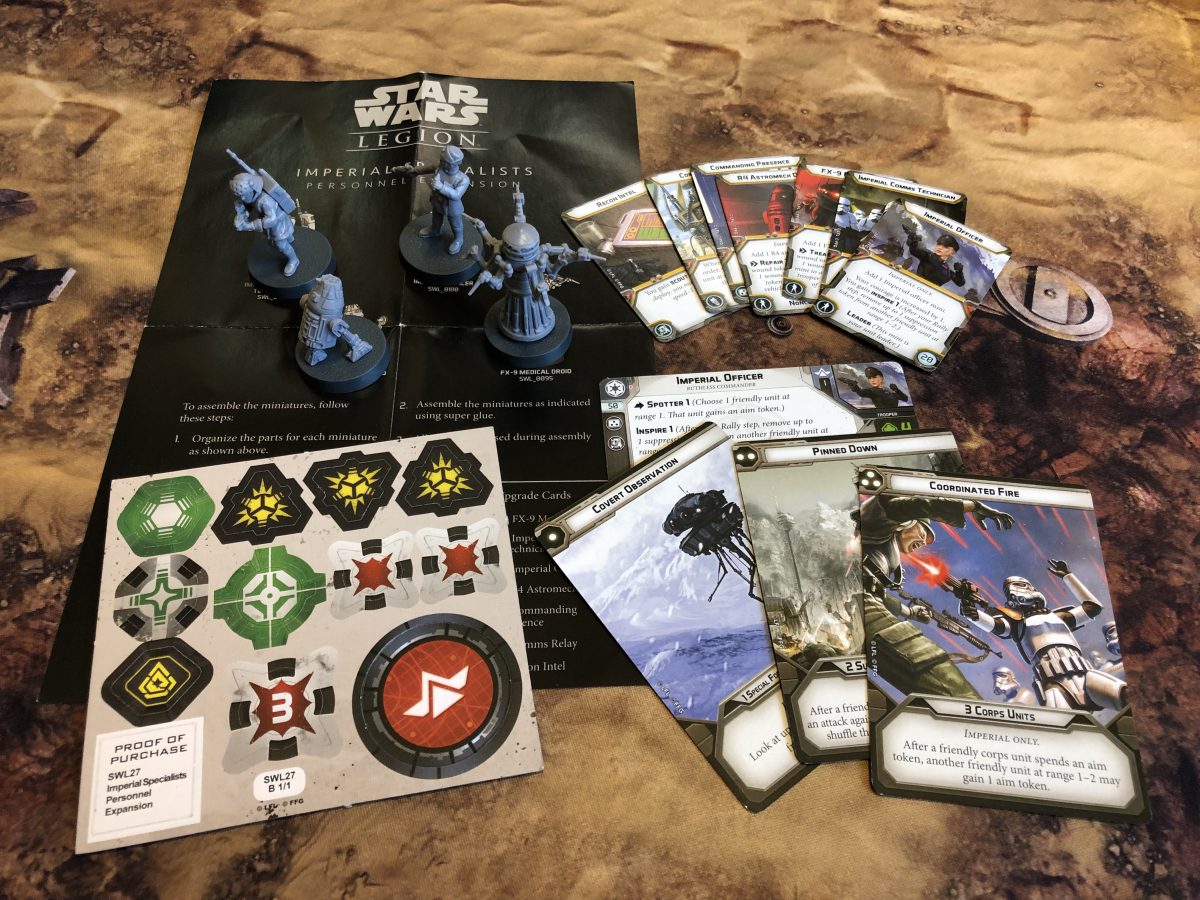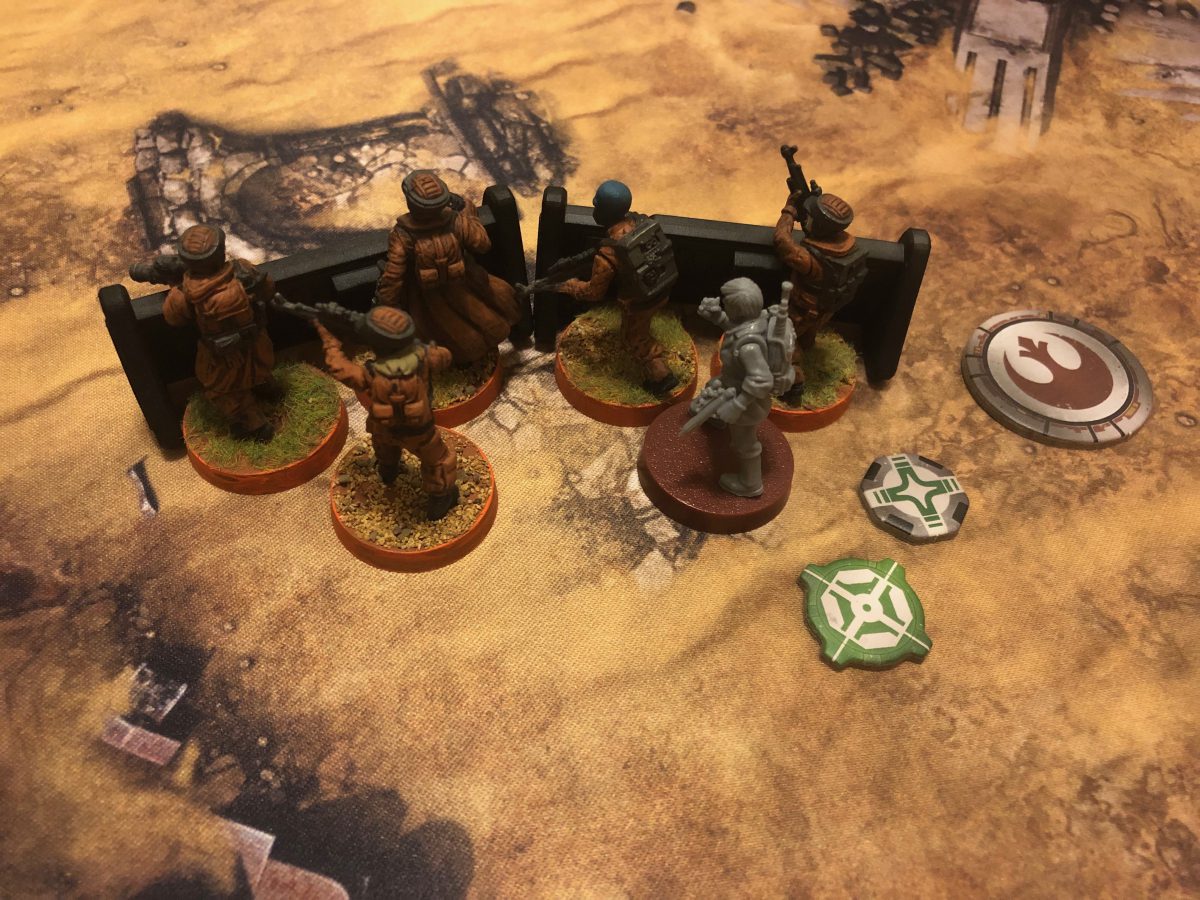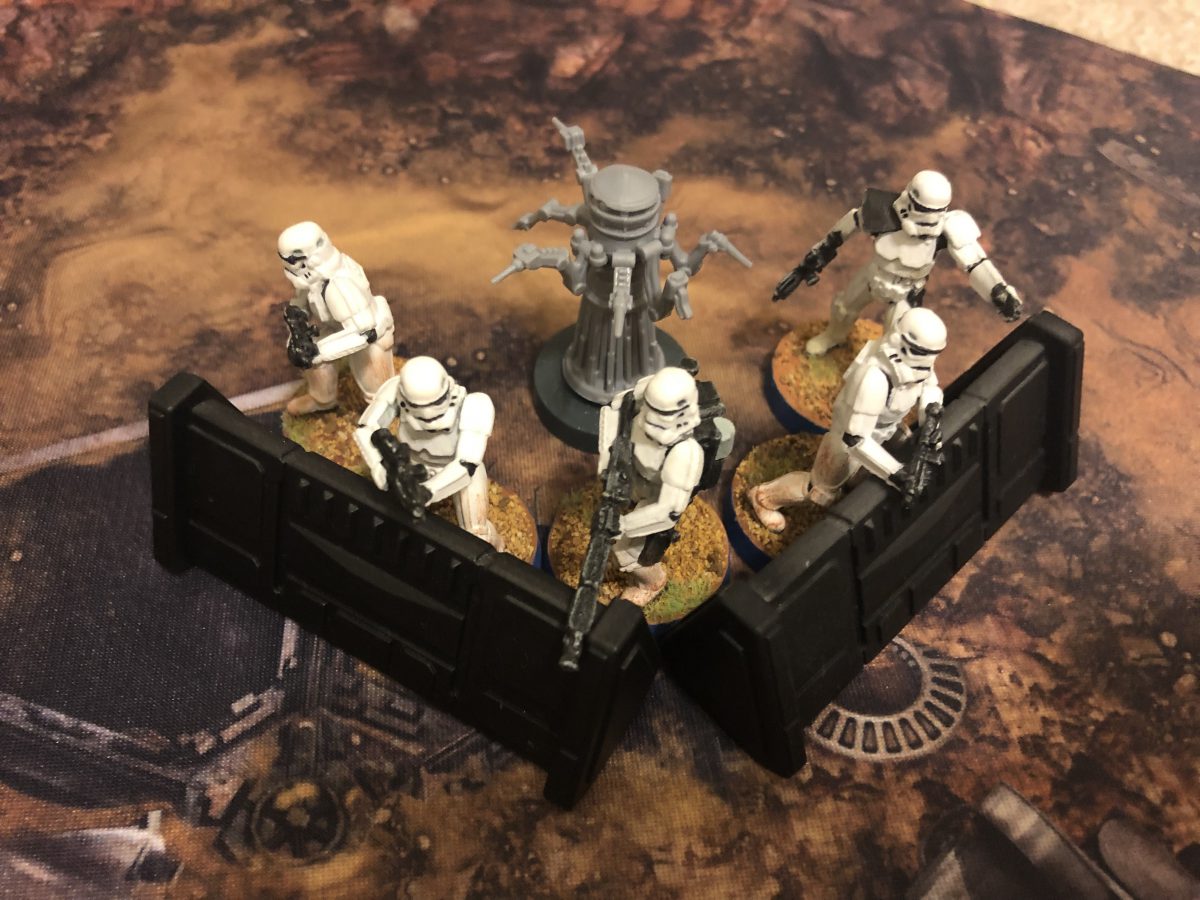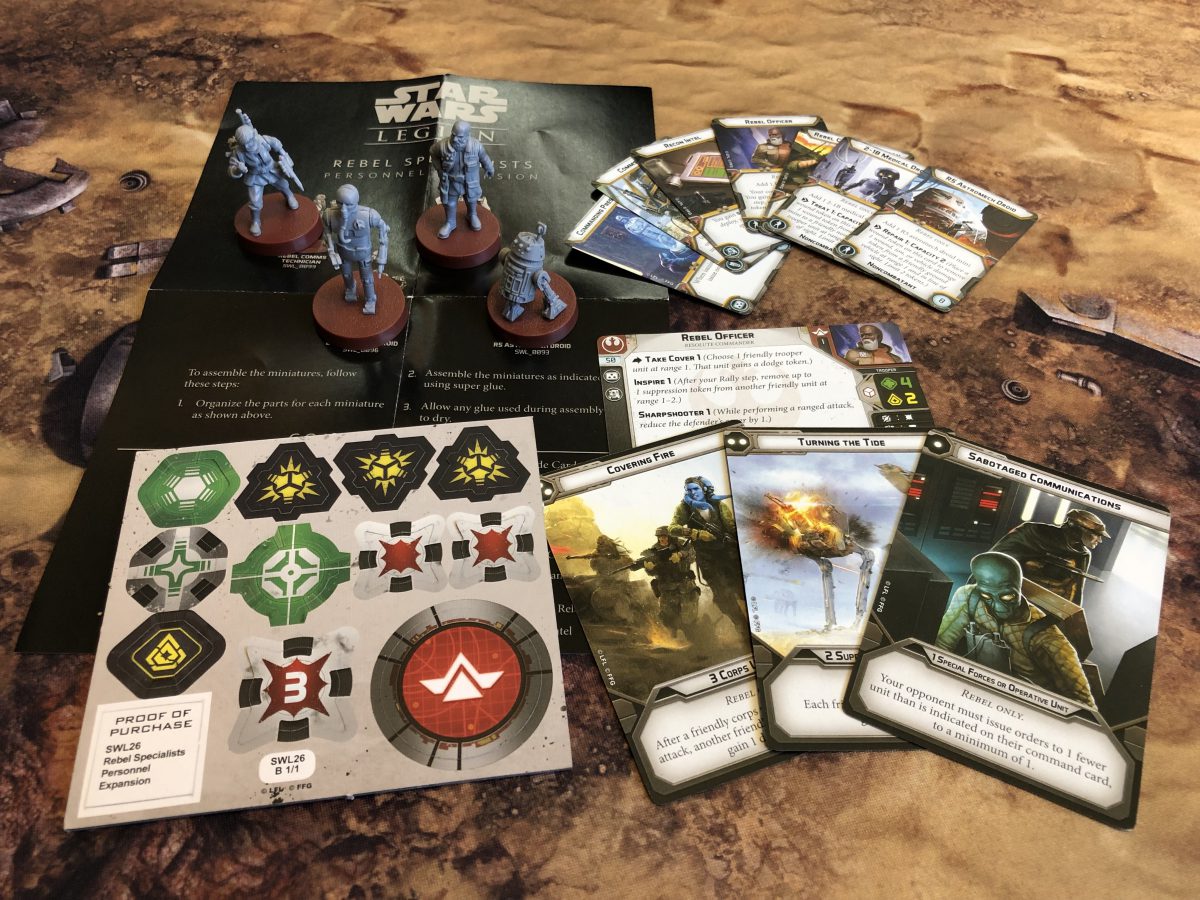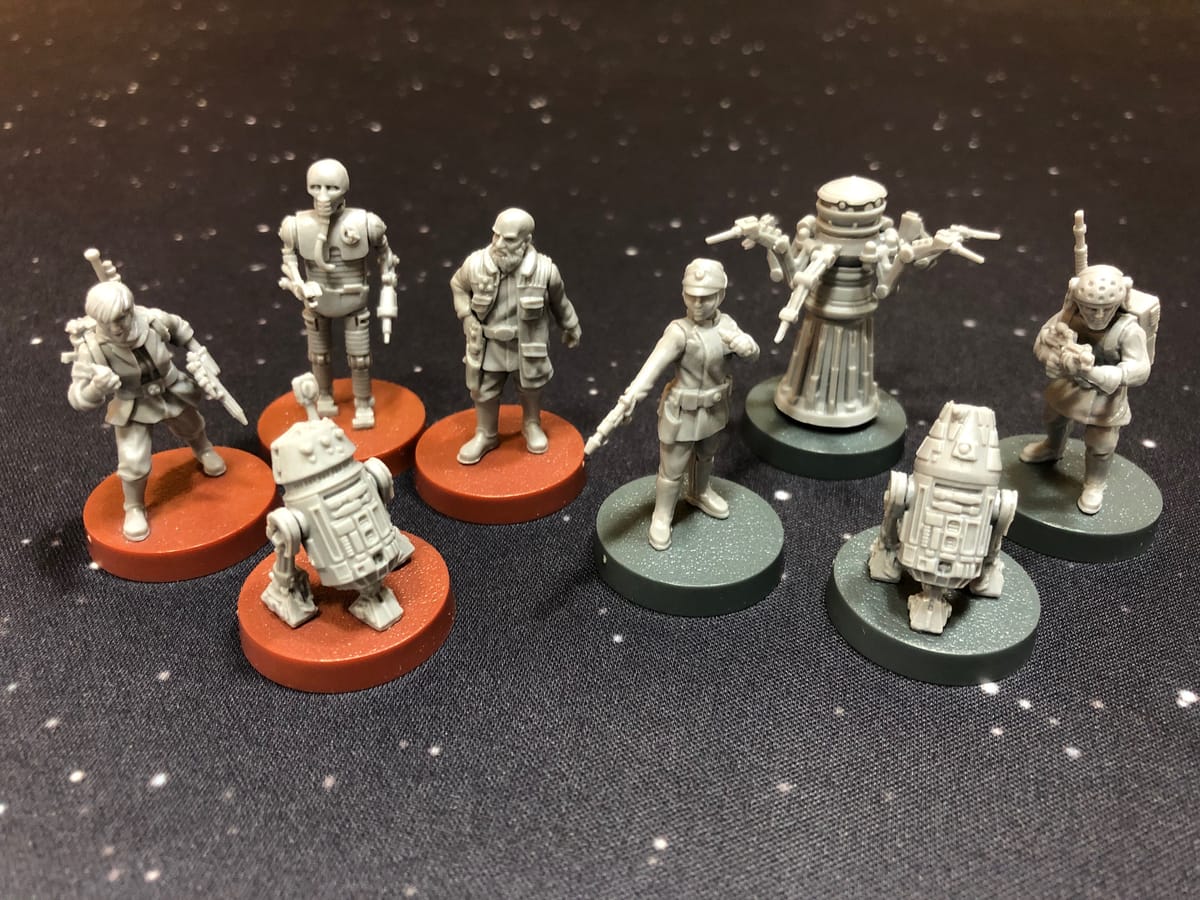
The Rebel Troopers are dug in behind heavy cover, but have taken some casualties from the intense fire coming from two fast-moving Imperial Speeder Bike units. Fortunately for the rebels, a 2-1B Medical Droid is nearby to aid in the recovery of one of the fallen. With a rebel trooper back in the fight, they might stay on the objective just a little longer. Across the battlefield, an Imperial Comms Technician relays commands from Darth Vader to a flanking squad of Stormtroopers, who are able to act at the perfect time, thanks to the improved communications. These are just two of the impacts that the Rebel Specialists and Imperial Specialists expansions for Star Wars: Legion (see our previous review) can have on the game. The sets are almost identical, each including an officer, a comms specialist, a medical droid, and an astromech droid, offering each side comparable upgrades to their base Trooper units. Specifically, the Imperial box contains an Imperial Officer, an Imperial Comms Technician, an FX-9 Medical Droid, and an R4 Astromech Droid while the Rebel box has a Rebel Officer, a Rebel Comms Technician, a 2-1B Medical Droid, and an R5 Astromech Droid. Both boxes contain their four respective minis, a sheet of tokens and two sets of cards – large format unit and command cards and small format upgrade cards.
The minis are excellent sculpts, easy to assemble, and look great on the table. In appearance, the astromechs, the Imperial officer, and the Rebel medical droid immediately call to mind their on-screen counterparts from the Star Wars movies. The rest are not necessarily as easily recognizable for a movie fan, but fit in perfectly with the flavor of the setting and may just have likely been drawn from the vast canon of animation, comics, and novels. Regardless, all of the minis look like members of the Star Wars Universe and fit right in next to Stormtroopers and Rebel Troopers. Adding some needed variety to the Imperial line up, the Imperial Leader is a female and the FX-9 Medical Droid is not a humanoid, but looks more like a pylon with seven arms tipped with syringes and other random medical gear. The astromechs are recognizably different from each other, so it is clear from across the table which side the droids are on. The minis did not have a lot of strong mold lines or require too much cleaning up. It was a bit of work to get the Imperial Comms Technician’s arms in place – they just didn’t fit well without a good deal of bending and there was a gap to fill. Overall, all the parts fit nicely together and there wasn’t too much work to prep them for painting.
Each of the minis comes with a Personnel upgrade card that is restricted to Rebel or Imperial side only. Using these upgrade cards, a player can add the individual mini to their army’s base Trooper Units in place of a standard trooper upgrade. Currently, that means that the specialists can upgrade a Stormtrooper, Snowtrooper, Rebel Trooper, or Fleet Trooper squad. The upgrades include the abilities that each of the minis brings to the fight. For the medical droids, they can restore a downed mini to a trooper unit or remove a wound token from a multi-wound trooper mini, restricted to range one. The astromechs can remove damage tokens from vehicles within range one. The Comms Technicians basically add a Comms upgrade slot to the unit they are attached to. The officers become the leader of the unit they are attached to and add Inspire 1, making the unit they are in a little more resilient under fire and helping nearby units deal with suppression. Three additional upgrade cards packed in each box are Recon Intel, Communications Relay, and Commanding Presence. The Communications Relay enables issuing orders to units within range 1-2 of the unit with the relay, extending the reach of a specific commander beyond three. Recon Intel gives the recipient Scout 1, letting the unit perform a one-speed move after deploying. Commanding presence extends a commander’s ability to orders to a range of four. Altogether, this collection of upgrade cards makes an army more survivable and increases its ability to spread out on the battlefield.
In addition to the upgrade cards, there are four additional large format cards in each box, three Command Cards and a Unit Card. With these in hand, players have the ability to field their Officer mini as a Commander for only fifty points (before upgrades, of course). They each come with a Command and a Gear upgrade slot, which can be filled with the upgrades in the box, Commanding Presence and Recon Intel. Ability-wise, the two officers are similar in that they each have Inspire 1 and Sharpshooter 1. The only way they differ is the Imperial Officer has Spotter 1, the ability to give an aim token to a nearby trooper unit, while the Rebel Officer has Take Cover 1, the ability to give a dodge token to a nearby trooper unit. The major differences between these two sets of cards is in the Command Cards. The cards in each box are labelled Rebel or Imperial only, but unlike other command cards, they are not limited to the specific commander in the box, so you can use them with any commander in your force, similarly to the basic command cards from the core set. The Command Cards each add a bonus to a specific unit when used, making them more powerful than the basic Command Cards, but they also limit the units that the orders can be issued to, so they are more limited in which armies they will be useful in. For instance, the basic one pip Ambush card lets you issue orders to any 1 Unit with no additional benefit, while the Rebel one pip Sabotaged Communications card limits you to issuing orders to one Special Force or Operative Unit, but reduces the number of orders your opponent can issue by one (to a minimum of 1). The extra set of command cards combined with the ability to field the Officers as Commanders are welcome additions to these expansions.
Unlike previous expansions to the game, rather than hitting the table as a whole unit, these minis individually augment units. The trooper units that can be augmented are only the basic troopers, so players should be able to find ways to get them to the table in at least one of their three mandatory trooper units, as long as they have enough wiggle room as far as points are concerned. In every case, the addition of a specialist to a trooper unit will change the way it plays.
The officers and comms technicians are both combatants, meaning they can contribute firepower to the fight. A trooper unit with either of these incorporated isn’t degraded in combat effectiveness, but does assume an extra role on the field, so you will most likely have to adjust the location of the unit on battlefield. With the comms technician, you will most likely want this unit to be located on the battlefield in relation to whatever upgrade the technician is packing. If it is retransmitting commands, then this trooper unit will be best placed on the edge of the commander’s range to maximize the range of the retransmission to outlying units – possibly giving a single-commander army more flexibility. Giving the comms technician a long range comms upgrade makes this trooper unit independent of range restrictions, so you can let them operate on an isolated objective. Adding the jammer upgrade means they need to be close to the enemy you want to block off, which may be fairly difficult in practice, because of the speed a trooper unit moves and terrain considerations. Adding the officer to a unit makes that unit essential to boosting others in the vicinity. The Inspire ability of the officer works best if another trooper unit or two are in close proximity, so the officer’s unit will probably need to be in the thick of things, or at least collocated with another trooper unit.
Unlike the officer and comms technicians, adding the medic or the astromech to a trooper unit degrades the offensive effectiveness of the unit because the droids are noncombatants. As noncombatants, not only do they not have weapons to contribute to an attack, they are also the last mini to be removed from a unit before the leader. So if a trooper unit with one of the droids takes a lot of hits, it can end up being a two man unit with just one weapon. The medics are the most useful of the two droids. Because their role is to heal troopers and they are embedded in trooper units, they can use their abilities on their own unit, but even though the specialists must be attached to trooper units, they can heal any mini with the trooper unit type. This means that the medics are not limited to healing just trooper units, they can work on any trooper unit type that might be nearby, which includes the commanders, operatives, and special forces units on the battlefield. A trooper unit with a medic can therefore give any nearby unit two hit recoveries, not just the unit that the medic is in. On the other hand, the astromech is dedicated to repairing vehicles, so its skillset is useless to the trooper unit it is attached to, while it still degrades that unit’s offensive capacity. The astromech can be a challenge to use. Keeping trooper units in close proximity to vehicles may not seem too difficult, but having a vehicle near a trooper unit with an astromech when the vehicle needs to be repaired can be difficult to pull off. Players will most likely need to develop strategies that tie specific vehicles and trooper units together to maximize astromechs. Otherwise, in a six turn game, trying to run a damaged vehicle across the battlefield to have a droid spend a turn or two repairing it is probably a losing strategy. The saving grace to the astromech is that it is the cheapest of the specialists, coming in at 8 points, which is even cheaper than the standard trooper mini it replaces in each unit.
Probably the best part of the expansions is that the two officers minis double as Commander units. These generic commanders and Command cards are not the only variation between the Imperial and Rebel sets – the commanders provide slightly different bonuses to the units. The Rebel commander provides Dodge tokens and the Imperial commander doles out Aim tokens. Otherwise, the Commander units provide the same benefits to each side. The command cards are not restricted to the officers in the Specialists expansions, but they are limited to their factions and each faction’s cads are quite different. Incorporating the command cards into an army will impact the way that the army is built (or, conversely, a player may decide to add them to an army build that can support them), but with the cards, a custom built army will benefit from the special ways they impact the battle. For instance, the Rebel two pip command card, titled Turning the Tide, restricts commands to 2 Support or Heavy Units, but adds the bonus, “Each friendly support and heavy unit gains Inspire 2.” Clearly, this card is most useful in an army with at least 2 of those units, but has a much greater impact than the generic two pip card from the core set.
In play, the medics tended to be the most useful additions to a unit. I found they required me to keep my Trooper Units in tighter groupings than I usually would, forcing me to struggle to keep them all in proper cover on a battlefield with less terrain. The Rebels seemed to handle the inclusion of a medic better than the Empire, but in both cases, they only worked when the units avoided heavy casualties in a single round. Since the medics only recover one damage per turn and only up to a maximum of two, the Troopers couldn’t just run out in the open and start drawing fire. Rather, they tended to last a turn or two longer on an objective. Also, the FX-9 mini has a nice different look, both in size and shape, but it was a little difficult to hide behind cover due to its height and spread out arms. The astromechs were a bit tougher to use. Unlike the medics, colocation with another unit isn’t just useful, it’s necessary for the astromechs. Trying to ensure that a Trooper Unit with an astromech moved close to a damaged vehicle, or moving a damaged vehicle close to an astromech was virtually impossible while trying to manage a planned fight. However, putting a Trooper Unit on an objective with an astromech attached and setting a walker beside them allowed the units to coordinate fire and the walker to be repaired after taking damage. The officers also benefited from close proximity to other units to maximize the Inspire ability. The comms technicians, unlike the other three specialists, worked best when the units were spread out across the battlefield. Regardless of the upgrade, Comms Relay, Jammer or otherwise, the unit benefits most when operating farther away from the main body of the army, either extending the commander’s ability to issue orders or interfering with the opponent’s ability to issue orders.
Star Wars: Legion Specialists
Great
A great addition to your collection that provides some options to diversify Trooper Units. Even if all the minis aren't useful to your army, the dual-use of the officer as either an upgrade to a unit or as a Commander and the extra command cards, which are usable with any commander, are worth it. Players need to be prepared to adjust the way they build and play armies based on which of the specialists they use and how they use them.
Pros
- The officers double as generic Commanders with a set of command cards.
- The Command cards can be used with any of the faction's commanders.
- Gives flexibility to trooper heavy lists.
Cons
- The Imperial medical droid is a big target.
- The astromech can be difficult to get to the right spot at the right time on the battlefield.

